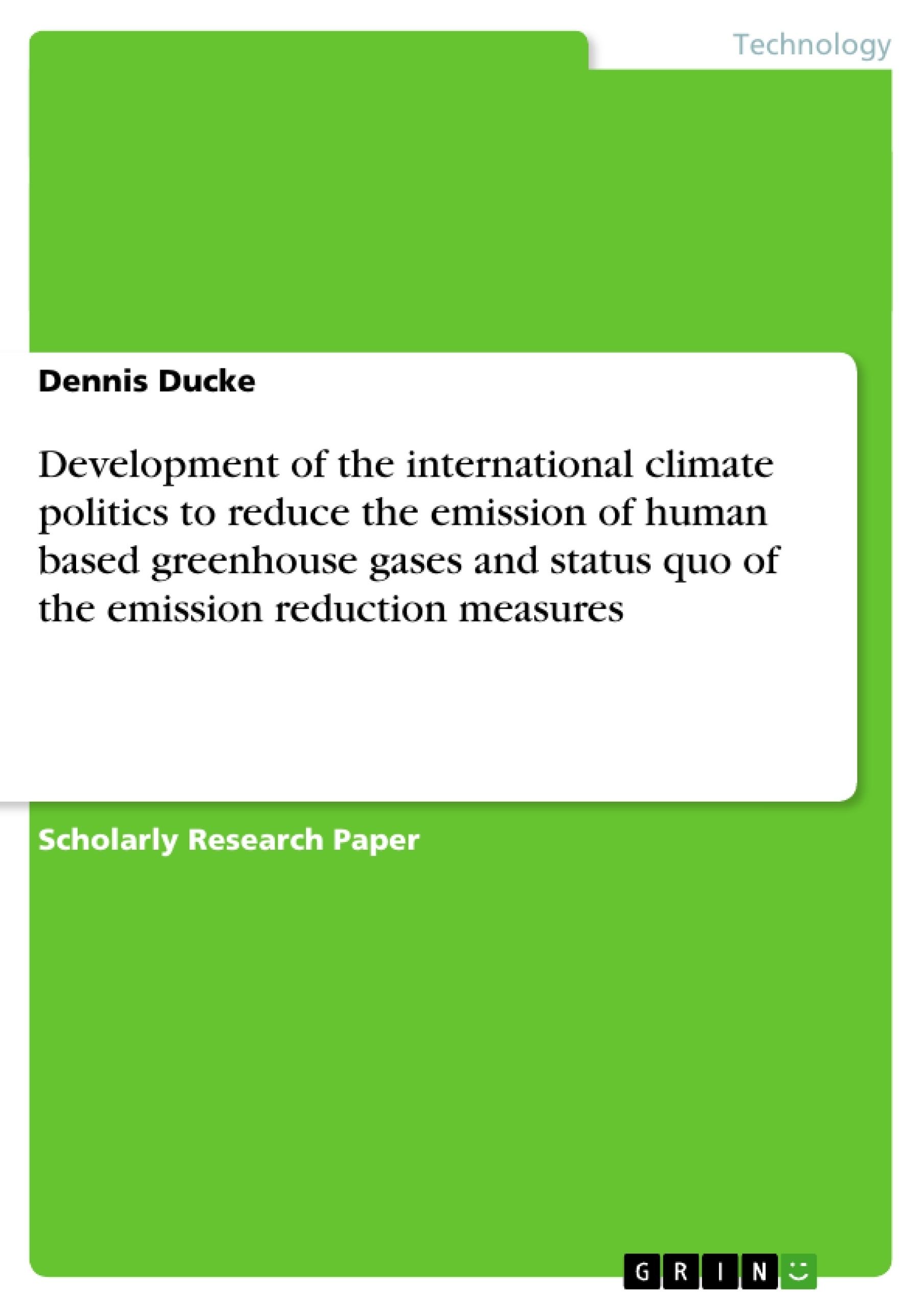Today the head of states of most countries are aware of the fact that the human-based greenhouse effect is one of the main reasons for global warming and the melting of the ice at the poles. Furthermore they have realized that this will lead to more natural catastrophes, than have already occurred. The scope of the present assignment is to point out what the international climate politics for reducing the human-based greenhouse effect and what is the status quo of emission reduction measures are. Therefore chapter one highlights the fundamentals of the greenhouse effect and which gases trigger it. Especially the carbon dioxide emissions lead to an increased warming of the earth with an amount of 9-26 per cent. The main cause for the greenhouse effect
with approximately 50 per cent is the burning of fossil energy sources like petrol or wood. Chapter two characterizes the development of international climate politics. Beginning in the year 1979 at the first world climate summit a worldwide binding climate
protection was first passed in December 1997 when the United Nations established a protocol at the Nations Conference in Kyoto which has the aim to “stabilize the amount of greenhouse gas concentrations in the atmosphere at a level that would prevent dangerous anthropogenic interference with the climate system”1. The protocol
establishes legally binding commitments for the reduction of greenhouse gases. So far 183 states have ratified the protocol. Furthermore three different Kyoto Mechanisms will be explained, that are to help to achieve the agreed climate goals. One of these mechanisms is Emission Trading that is used on the one hand on national level within the Kyoto Protocol and on the other hand on company level. The use on company level is implemented in the European Union Emission Trading System that
will be described in chapter three. By using a cap & trade system the governments of the participant countries try to create incentives for selected sectors to reduce their emission level. This is supposed to be realized by a continuously lowered cap for produced emissions. This lowering is divided in three main phases. The first phase from
2005 to 2007 was a testing phase which covered ~ 50 per cent of the national CO2 emissions. The second phase from 2008 to 2012 reduces the emission allowances and includes other greenhouse gases.The third phase will start in 2013 and will again reduce the emission limits and other sectors such as aviation and...
Inhaltsverzeichnis (Table of Contents)
- EXECUTIVE SUMMARY
- TABLE OF CONTENTS
- INTRODUCTION
- THE KYOTO PROTOCOL
- Historical development
- Ratification of the Kyoto Protocol
- Burden sharing
- Kyoto Mechanism
- Clean Development Mechanism
- Joint Implementation
- Emission Trading
- THE EUROPEAN UNION EMISSION TRADING SYSTEM
- Basic information
- The Cap & trade system
- The EU ETS phases
- Phase I (2005-2007)
- Phase II (2008-2012)
- Phase III (2012-2020)
- DEVELOPMENT OF GREENHOUSE GAS EMISSIONS
- The worldwide trend for carbon dioxide emissions
- The development in the European Union
- Development in Germany
- CONCLUSION
Zielsetzung und Themenschwerpunkte (Objectives and Key Themes)
This assignment aims to explore the development of international climate politics in relation to reducing human-induced greenhouse gas emissions. It delves into the status quo of existing emission reduction measures and their effectiveness. The key themes of the text include: * The causes and impacts of the greenhouse effect * The development of international climate politics, particularly the Kyoto Protocol and its mechanisms * The European Union Emission Trading System (EU ETS) and its implementation phases * The current trends in greenhouse gas emissions worldwide, with a focus on the European Union and GermanyZusammenfassung der Kapitel (Chapter Summaries)
- Introduction: This chapter provides a brief overview of the greenhouse effect and its causes, emphasizing the role of carbon dioxide emissions from fossil fuels.
- The Kyoto Protocol: This chapter traces the historical development of the Kyoto Protocol, outlining its objectives and the ratification process. It also explores the burden sharing aspects and the three key mechanisms: Clean Development Mechanism, Joint Implementation, and Emission Trading.
- The European Union Emission Trading System: This chapter focuses on the EU ETS, a cap & trade system designed to incentivize emissions reduction in specific sectors. It delves into the basic principles of the system and the three phases of implementation.
- Development of Greenhouse Gas Emissions: This chapter examines the global trend of carbon dioxide emissions, particularly within the European Union and Germany, providing insights into emissions development and potential mitigation strategies.
Schlüsselwörter (Keywords)
The key concepts explored in this assignment include greenhouse effect, climate change, international climate politics, Kyoto Protocol, Kyoto Mechanisms, emission trading, EU ETS, carbon dioxide emissions, and emission reduction measures. The text delves into the development and implementation of these policies and measures to address the pressing issue of climate change.- Citation du texte
- Dennis Ducke (Auteur), 2009, Development of the international climate politics to reduce the emission of human based greenhouse gases and status quo of the emission reduction measures, Munich, GRIN Verlag, https://www.grin.com/document/141665



